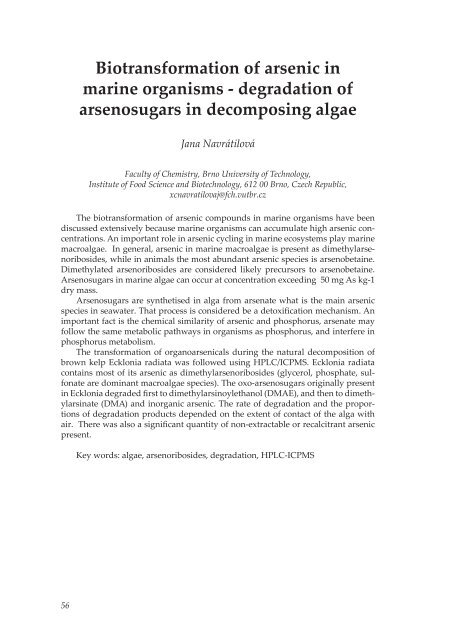Sborník abstraktů 2010 - Fakulta chemická - Vysoké učení technické ...
Sborník abstraktů 2010 - Fakulta chemická - Vysoké učení technické ...
Sborník abstraktů 2010 - Fakulta chemická - Vysoké učení technické ...
You also want an ePaper? Increase the reach of your titles
YUMPU automatically turns print PDFs into web optimized ePapers that Google loves.
Biotransformation of arsenic in<br />
marine organisms - degradation of<br />
arsenosugars in decomposing algae<br />
Jana Navrátilová<br />
Faculty of Chemistry, Brno University of Technology,<br />
Institute of Food Science and Biotechnology, 612 00 Brno, Czech Republic,<br />
xcnavratilovaj@fch.vutbr.cz<br />
The biotransformation of arsenic compounds in marine organisms have been<br />
discussed extensively because marine organisms can accumulate high arsenic concentrations.<br />
An important role in arsenic cycling in marine ecosystems play marine<br />
macroalgae. In general, arsenic in marine macroalgae is present as dimethylarsenoribosides,<br />
while in animals the most abundant arsenic species is arsenobetaine.<br />
Dimethylated arsenoribosides are considered likely precursors to arsenobetaine.<br />
Arsenosugars in marine algae can occur at concentration exceeding 50 mg As kg-1<br />
dry mass.<br />
Arsenosugars are synthetised in alga from arsenate what is the main arsenic<br />
species in seawater. That process is considered be a detoxification mechanism. An<br />
important fact is the chemical similarity of arsenic and phosphorus, arsenate may<br />
follow the same metabolic pathways in organisms as phosphorus, and interfere in<br />
phosphorus metabolism.<br />
The transformation of organoarsenicals during the natural decomposition of<br />
brown kelp Ecklonia radiata was followed using HPLC/ICPMS. Ecklonia radiata<br />
contains most of its arsenic as dimethylarsenoribosides (glycerol, phosphate, sulfonate<br />
are dominant macroalgae species). The oxo-arsenosugars originally present<br />
in Ecklonia degraded first to dimethylarsinoylethanol (DMAE), and then to dimethylarsinate<br />
(DMA) and inorganic arsenic. The rate of degradation and the proportions<br />
of degradation products depended on the extent of contact of the alga with<br />
air. There was also a significant quantity of non-extractable or recalcitrant arsenic<br />
present.<br />
Key words: algae, arsenoribosides, degradation, HPLC-ICPMS

















